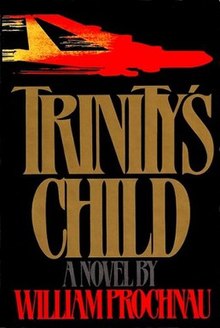Trinity's Child
Trinity's Child is a 1983 novel by William Prochnau. The book depicts a nuclear war waged between the United States of America and the Soviet Union.[1] During the waning years of the Cold War, the United States has engaged in a massive military buildup, hoping to press the economy of the Soviet Union to breaking point and so force them into political compromise.
 First edition | |
| Author | William Prochnau |
|---|---|
| Language | English |
| Publisher | Putnam Pub Group |
Publication date | October 1983 |
| Pages | 400 (Hardcover) |
| ISBN | 978-0-399-12777-9 |
In the book's scenario, hardline elements pressure the Soviet Premier into launching an attack on the US before it has the chance to squeeze the Soviets any more.
The attack goes forward, and all the consequences of the doomsday scenario are laid bare, with conflicting claimants to the US presidency as the line of succession breaks apart, devastation on the ground, and military staff having to choose between a treason which might save what's left of their country, and a duty which might lead to the extinction of the human race itself.
The novel covers fifteen hours in which critical decisions are made.
Plot
The president of the United States is informed by the head of SAC that a Soviet first strike is underway. The Soviet Premier offers the United States three choices via a HOTLINE message:
- Accept the damage and the exchange will end.
- Respond in kind, which will cause the deaths of 3 to 9 million people on both sides.
- Respond with a massive counterattack (to which the Soviets would respond in kind).
As the order to respond in kind is passed on, the first wave of Soviet ICBMs and SLBMs arrive, crippling most of America's missile silos and bomber bases. A Soviet missile detonates near Chevy Chase, Maryland and the president is told the Soviets have launched a second strike. The president reluctantly gives a second order to respond just before SAC and Omaha, Nebraska are destroyed. As he is being evacuated from the White House, the president is told that the second Soviet launch was directed at the Chinese. This causes further strikes against the United States. A nearby detonation causes Marine One to crash, seemingly killing the president.
As missiles speed towards their targets and the alert goes out, the novel begins its sub-plot: tracking the actions of "Polar Bear One," a nuclear-armed B-52 bomber. The craft speeds towards the Soviet Union to await orders.
Believing the President to be dead, a US Navy admiral codenamed "Harpoon" is given the assignment of locating a successor, who turns out to be the Secretary of the Interior. He is sworn in and given the codename "Condor." Harpoon's Boeing E-4B becomes the American military's new command center. It's revealed that, along with Omaha, Baton Rouge, Seattle, Los Angeles, Colorado Springs, New Orleans, Phoenix, Raleigh, Honolulu, and Washington, D.C. have been destroyed. Massive social disorder and rioting have broken out in America's remaining cities. It is briefly mentioned that Europe remained neutral during the conflict and that India and Israel have declared war on Pakistan.
Harpoon urges Condor to turn the bombers around to see if the Soviets respond in kind as a way of signaling an intent to de-escalate since communications are down and direct talks are not yet possible. Colonel Fargo, a Soviet capabilities expert, suggests a decapitation strike targeting Soviet leadership bunkers with American's nuclear submarines. Believing that the US is "losing" the war, Condor orders the decapitation strike. Polar Bear One refuses the E-4B's orders and turns around. Seeing it as a sign for a truce, the Soviets turn 15 of their bombers around. Condor is urged by "Alice," now in charge of SAC aboard the Looking Glass Plane, to turn another squadron of B-52s in response. Condor refuses.
It is then revealed that the president is alive in a Federal Emergency Management Agency bunker outside of Olney, Maryland. He learns that the Soviet premier is attempting to make contact through shortwave radio. The two negotiate a cease-fire. The president then contacts Alice, whom he orders to turn the bombers around. Alice, an Air Force general, cannot issue direct orders to the Navy, and the President's identity codes conflict with Condor's. The president contacts Condor, urging him to help secure a cease-fire. Condor, thinking he is a Soviet imposter, refuses. Alice tells the President that if both he and Condor give the submarines two different sets of orders, the submarines will go with the original orders (Condor's). The president and Alice attempt to create a plan to stop Condor. Alice suggests using the Looking Glass as a weapon to intercept the E-4B, thus killing Condor and relinquishing authority to the president.
Alice attempts to catch up to Condor during a seven-hour window until the submarines surface to listen for new orders, at which time Condor will give the order for the decapitation strike. With minutes left, the flight crew of the E-4B, loyal to Alice, turn the plane into the path of the Looking Glass, killing everyone on board both. Command is returned to the president, who orders a full cessation of hostilities. The Soviet Union responds in kind, however, Polar Bear One's fate and the outcomes of the conflicts in the Middle East and between the Soviets and Chinese are left unanswered.
Television adaptation
The book was made into a 1990 television movie, By Dawn's Early Light. There are some significant differences between the two; most significantly, in the movie the initial nuclear exchange is prompted by renegade Soviet terrorists rather than part of a Soviet plot. Another element of the movie is a romantic subplot between the captain of the B-52 and his female co-pilot, which is absent from the book.
References
- "Nuclear Holocausts: Atomic War in Fiction, 1895-1984" by Paul Brians, Kent State University Press, 1987